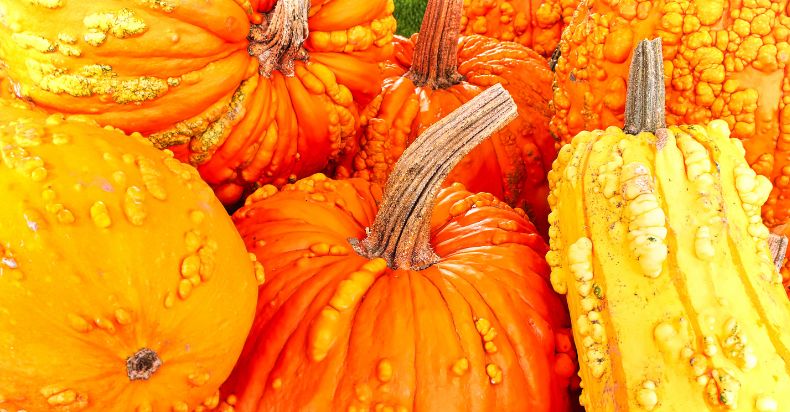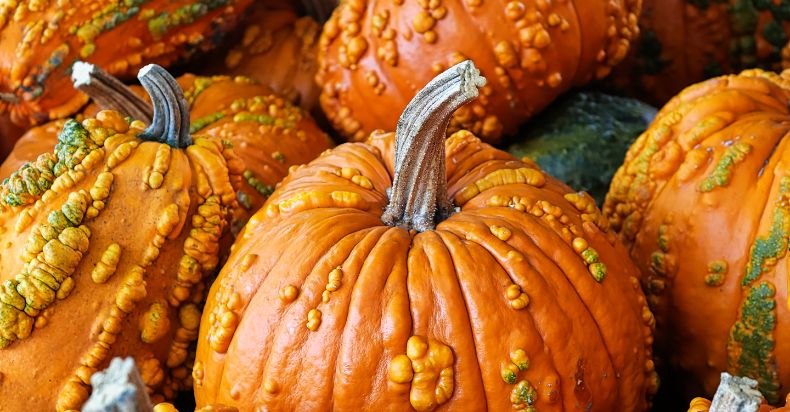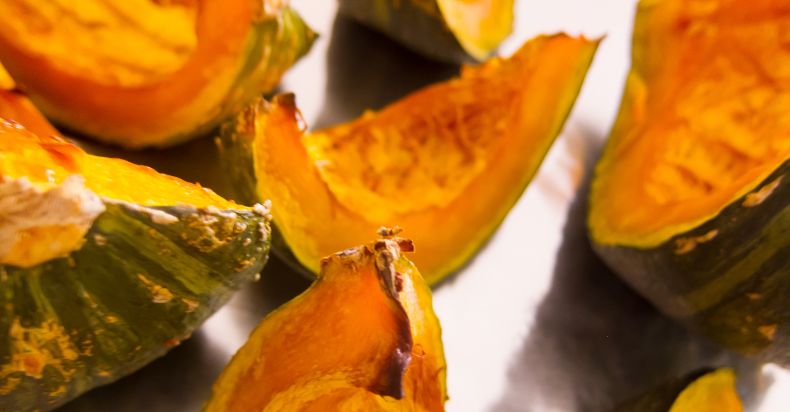Yes, Bumpy squash is absolutely safe to eat. Despite their rough exterior, bumpy squashes are perfectly safe to eat. The bumps on the squash are natural and do not indicate any harm or danger.
The world of squashes is as diverse as it is delicious. From the smooth-skinned butternut to the ridged acorn, and yes, the bumpy varieties too, each type of squash brings something unique to the table.
But it’s those bumpy ones that seem to cause the most confusion. Their rough exterior can be a bit intimidating, and let’s be honest, they’re not winning any beauty contests. But does that mean they’re unsafe to eat?
If you’ve ever found yourself in the produce aisle, staring at a particularly bumpy squash and wondering, “Is this thing safe to eat?” then you’re in the right place.
That’s the mystery we’re here to solve. We’re going on a deep dive into the world of bumpy squashes, exploring what they are, why they’re bumpy, and most importantly, whether they’re safe to eat.
In this comprehensive guide, we’ll not only answer the burning question “Is bumpy squash safe to eat?” but we’ll also give you tips on how to choose and prepare bumpy squash, explore the health benefits of this underrated vegetable, and answer some frequently asked questions.
By the end of this article, you’ll be a bona fide bumpy squash expert, ready to impress your friends and family with your newfound knowledge. So, without further ado, let’s jump right in!
What is Bumpy Squash?

Alright, before we dive into the nitty-gritty, let’s get our definitions straight. What exactly is this bumpy squash we’re talking about?
Well, if you’re imagining a squash that looks like it’s been through a round or two with a meat tenderizer, you’re on the right track.
Bumpy squash, as the name suggests, is a type of squash that has a rough, bumpy skin. It's like the rebellious teenager of the squash family, refusing to conform to the smooth-skinned norms of its butternut and spaghetti squash cousins.
But don’t let its rugged exterior fool you. Underneath that tough skin lies a heart of gold… or rather, a heart of delicious, tender flesh.
Bumpy squash comes in various shapes, sizes, and colors. You’ve got your small, yellow summer squash, also known as pattypan squash, with its scalloped edges and bumpy surface.
Then there’s the larger, green winter squash, like the kabocha or Hubbard squash, with their hard, bumpy skin. Each type has its unique flavor and texture, but they all share one thing in common: those distinctive bumps.
But why are they bumpy, you ask? Well, those bumps are completely natural and are a result of the squash’s growing process. As the squash grows, it develops a thick skin to protect itself.
This skin can sometimes grow unevenly, resulting in bumps. So, the next time you see a bumpy squash, don’t be put off by its rough exterior. Those bumps are just a sign of a squash that’s had to tough it out in the wild… or, you know, the farm.
So, now that we know what a bumpy squash is, let’s tackle the question that’s been on everyone’s mind: Is bumpy squash safe to eat? Stay tuned to find out!
READ : Is It Safe to Eat Bell Pepper With Black Spots Inside?
Is Bumpy Squash Safe to Eat?

Now, let’s get to the heart of the matter. Is bumpy squash safe to eat? The suspense is killing me… Drumroll, please… And the answer is… Yes! Bumpy squash is absolutely safe to eat.
I know, I know, it’s a bit anticlimactic. But it’s true. Despite their rough exterior, bumpy squashes are perfectly safe to eat. The bumps on the squash are natural and do not indicate any harm or danger.
In fact, they’re just a result of the squash’s growing process. As the squash matures, it develops a thick skin to protect itself. This skin can sometimes grow unevenly, resulting in bumps.
But here’s the kicker: not only are these bumps harmless, but they can also add to the squash’s unique texture when cooked. That’s right, those bumps can actually make your squash dish more interesting.
So, instead of being a cause for concern, they can be a cause for celebration.
However, it’s important to note that while the bumps themselves are harmless, you should still check the squash for any signs of rot or mold, such as soft spots, discoloration, or a foul smell. These could indicate that the squash is spoiled and should not be eaten.
So, the next time you see a bumpy squash, don’t be afraid. Embrace the bumps! They’re not a sign of danger, but a sign of deliciousness.
But how do you choose a good bumpy squash, and how do you prepare it? Well, that’s exactly what we’re going to explore in the next section.
READ : How Much Carrot Juice is Safe to Drink Daily?
How to Choose and Prepare Bumpy Squash?

Choosing a good bumpy squash is like choosing a good book – it’s all about looking beyond the cover.
When you’re in the produce aisle, don’t be put off by the rugged exterior of a bumpy squash. Instead, look for a firm, heavy squash with a dull skin.
The skin should be free of cuts or bruises, and the squash should feel heavy for its size. This is a sign of a squash that’s ripe and ready to eat.
Once you’ve chosen your bumpy squash, it’s time to prepare it. Now, I know what you’re thinking. “How on earth do I tackle this beast?” Well, fear not, because preparing a bumpy squash is easier than you might think.
First, give your squash a good wash. Those bumps can harbor dirt, so you’ll want to make sure it’s nice and clean before you start cooking. Then, cut off the ends of the squash. This will give you a stable base to work with.
Now, here’s where things get a bit controversial. To peel or not to peel, that is the question. The skin of a bumpy squash is edible, but it can be a bit tough, especially in larger varieties.
If you’re making a soup or a puree, you might want to peel the squash to ensure a smooth texture. But if you’re roasting or grilling the squash, leaving the skin on can add a nice bit of texture.
Once you’ve decided on the peel, it’s time to cut the squash. Cut it in half, scoop out the seeds, and then cut it into slices or cubes, depending on your recipe. And voila! Your bumpy squash is ready to be cooked.
But wait, there’s more! Not only is bumpy squash safe to eat and easy to prepare, but it’s also packed with health benefits. Let’s explore those in the next section.
READ : Is It Safe to Eat Mushrooms With Brown Spots?
Health Benefits of Bumpy Squash:
Not only is bumpy squash safe to eat, but it’s also a nutritional powerhouse. It’s like the superhero of the vegetable world, packed with nutrients and ready to save the day.
So, what exactly are these health benefits? Let’s break it down.
First off, bumpy squash is a great source of vitamins A and C. Vitamin A is essential for good vision, a healthy immune system, and cell growth. It’s like the body’s personal bodyguard, protecting it from harmful invaders.
On the other hand, vitamin C is a powerful antioxidant that helps protect the body from damaging free radicals. It’s also crucial for the growth and repair of tissues in all parts of your body.
But that’s not all. Bumpy squash is also high in fiber, which is essential for a healthy digestive system. It helps to keep your gut happy and your bowel movements regular. So, if you’re looking for a natural way to keep things moving, bumpy squash is your friend.
And let’s not forget about potassium. This essential mineral helps to regulate fluid balance, muscle contractions, and nerve signals. It’s like the body’s personal traffic controller, making sure everything runs smoothly.
Plus, bumpy squash is low in calories, making it a great addition to any diet. It’s a delicious way to fill up without filling out, if you know what I mean.
So, there you have it. Bumpy squash is not only safe to eat, but it’s also a nutritional powerhouse. It’s a delicious, healthy addition to any meal. But don’t just take my word for it. Try it for yourself and experience the health benefits of bumpy squash.
READ : What Causes The Brown Spots On Potatoes?
Key Takeaways:
So, there you have it. Bumpy squash, the underdog of the squash world, is not only safe to eat, but it's also delicious and packed with nutrients. It's a testament to the old saying, "Don't judge a book by its cover." Or in this case, "Don't judge a squash by its bumps."
From its rugged exterior to its tender, flavorful flesh, bumpy squash is a vegetable that deserves a spot in your kitchen. It’s versatile, nutritious, and let’s be honest, it’s a great conversation starter.
So, the next time you see a bumpy squash in the store, don’t be afraid to give it a try. Embrace the bumps. Celebrate the bumps. Because those bumps are a sign of a squash that’s ready to be enjoyed.
But our journey into the world of bumpy squash doesn’t end here. There are still many questions to be answered. So, without further ado, let’s dive into some frequently asked questions about bumpy squash.
Frequently Asked Questions
Why is my squash bumpy?
The bumps on a squash are natural and are a result of the growing process. As the squash matures, it develops a thick skin to protect itself.
This skin can sometimes grow unevenly, resulting in bumps. So, those bumps are a sign of a squash that’s had to tough it out in the wild… or, you know, the farm.
Do I need to peel bumpy squash before eating?
It depends on your recipe and personal preference. The skin of the squash is edible but can be tough, especially in larger varieties.
If you’re making a soup or a puree, you might want to peel the squash to ensure a smooth texture. But if you’re roasting or grilling the squash, leaving the skin on can add a nice bit of texture.
Can I eat raw bumpy squash?
Yes, you can eat raw bumpy squash, especially the smaller, tender varieties.
However, most people prefer to cook it as it softens the squash and brings out its flavor. Plus, cooking makes it easier to digest.
How do I store bumpy squash?
Store uncut bumpy squash in a cool, dry place. It should last for a month or more.
Once cut, wrap the squash in plastic and store it in the fridge. It should last for about a week.
What can I make with bumpy squash?
Bumpy squash is incredibly versatile. You can roast it, grill it, sauté it, or use it in soups and stews.
You can even stuff it and bake it. The possibilities are endless!
So, go ahead and embrace the bumps. They’re not a sign of danger, but a sign of deliciousness. Happy cooking!
